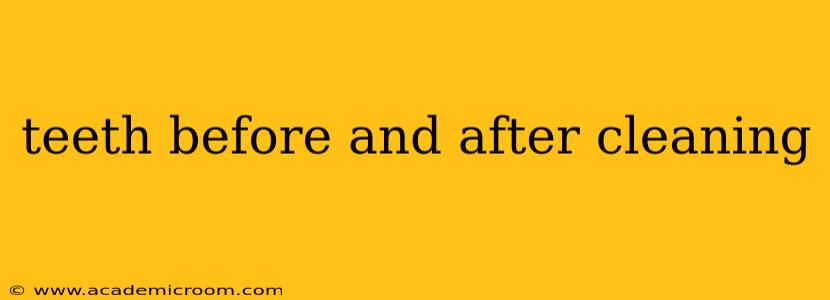Maintaining optimal oral hygiene is crucial for a healthy and confident smile. Regular professional cleanings play a vital role in this process, removing plaque and tartar buildup that even diligent brushing and flossing can't completely eliminate. The difference between a before-and-after professional cleaning is often dramatic, showcasing the transformative power of preventative dental care. Let's explore the noticeable changes you can expect.
What Happens During a Professional Teeth Cleaning?
A professional cleaning, also known as a prophylaxis, typically involves several steps:
- Examination: The dentist or hygienist will examine your teeth and gums to assess their overall health, checking for cavities, gum disease, and other issues.
- Removal of Plaque and Tartar: This is the core of the cleaning. Special instruments like scalers and ultrasonic devices are used to carefully remove plaque (a sticky film of bacteria) and tartar (hardened plaque) from the tooth surfaces, both above and below the gum line.
- Polishing: After removing plaque and tartar, the teeth are polished to remove surface stains and leave them feeling smooth. This polishing often involves a gritty paste and a rotating brush.
- Fluoride Treatment: A fluoride treatment is often applied to help strengthen tooth enamel and protect against future decay.
What's the Difference Between Teeth Before and After Cleaning?
The visual difference between your teeth before and after a professional cleaning is often significant. Here's a breakdown:
- Color: Your teeth will appear noticeably whiter and brighter after a cleaning. Surface stains from coffee, tea, tobacco, and other substances are removed, revealing the natural color of your enamel.
- Texture: Before cleaning, your teeth may feel rough due to plaque and tartar buildup. After the cleaning, they'll feel significantly smoother. This smoothness is not only more pleasant to the touch but also helps prevent future plaque accumulation.
- Gum Health: If you have gingivitis (gum inflammation), you may notice a reduction in redness and swelling after a professional cleaning. The removal of plaque and tartar reduces irritation to the gums.
- Breath Freshness: A significant improvement in breath freshness is a common result of professional cleaning, as the removal of bacteria eliminates bad breath caused by oral malodor.
How Often Should You Get Your Teeth Professionally Cleaned?
Most dental professionals recommend getting your teeth professionally cleaned every six months. However, individuals with specific oral health conditions may require more frequent cleanings. Your dentist can determine the best cleaning schedule for your individual needs.
What if My Teeth Still Look Yellow After Cleaning?
While professional cleanings effectively remove surface stains, they don't address deeper discoloration caused by factors like aging, medication, or genetics. If you're concerned about the color of your teeth after a cleaning, discuss teeth whitening options with your dentist.
How Can I Maintain My Clean Teeth?
Maintaining your bright, clean smile requires a consistent oral hygiene routine at home. This includes:
- Brushing: Brush your teeth twice a day with fluoride toothpaste for at least two minutes each time.
- Flossing: Floss daily to remove plaque and food particles from between your teeth.
- Mouthwash: Using an antimicrobial mouthwash can help kill bacteria and freshen breath.
- Healthy Diet: Limit sugary drinks and snacks to minimize plaque buildup.
Can Professional Cleaning Prevent Gum Disease?
Yes, regular professional cleanings are a crucial part of preventing gum disease (periodontitis). By removing plaque and tartar buildup, cleanings help reduce inflammation and prevent the progression of gum disease.
Are Professional Cleanings Painful?
Professional cleanings are typically not painful. While you may experience some mild discomfort or sensitivity during the scaling process, this is usually temporary and easily managed.
By understanding the benefits of professional teeth cleaning and committing to a thorough home care routine, you can maintain a healthy, beautiful smile for years to come. Remember to consult your dentist regularly for check-ups and professional cleanings.
